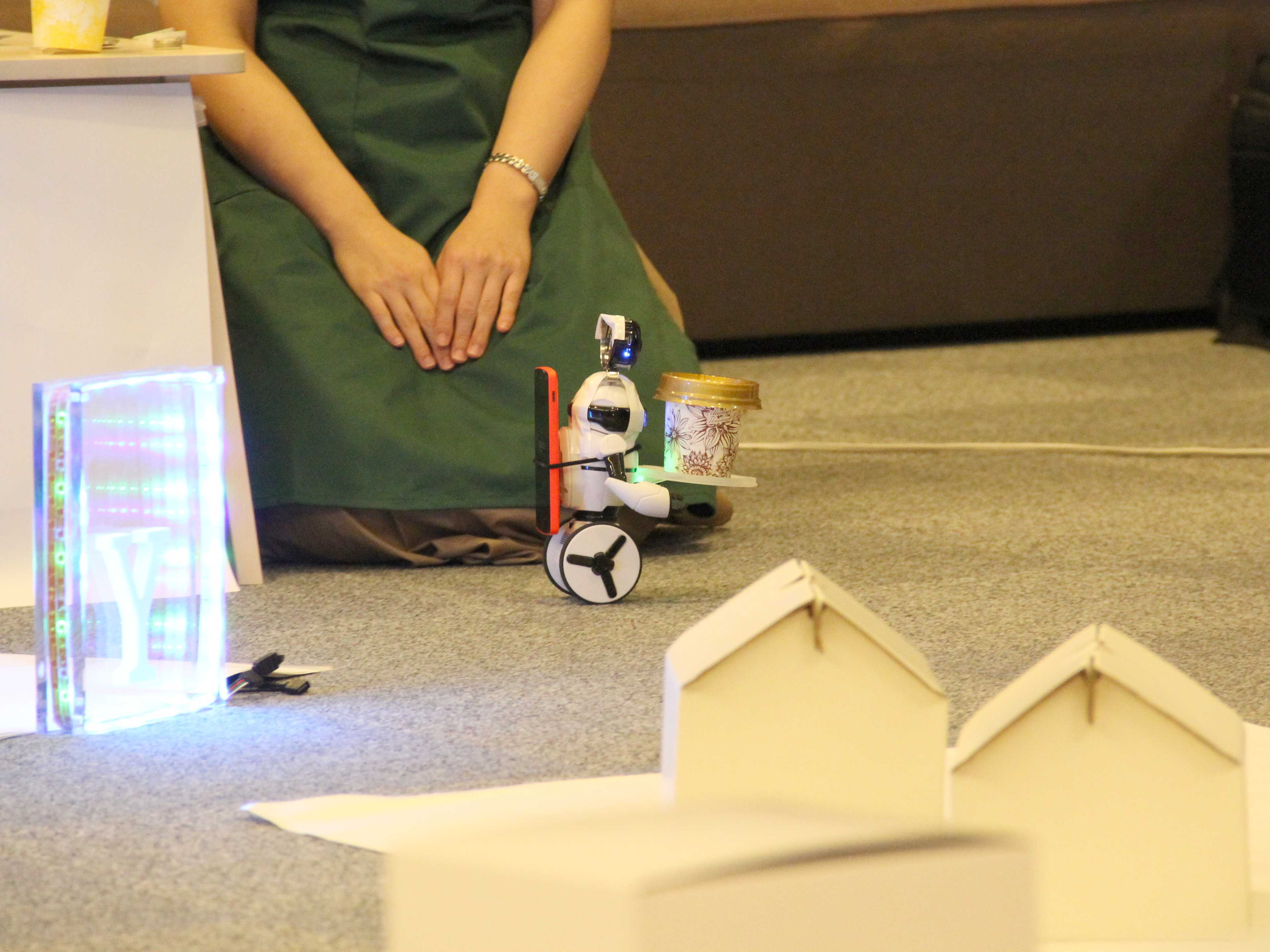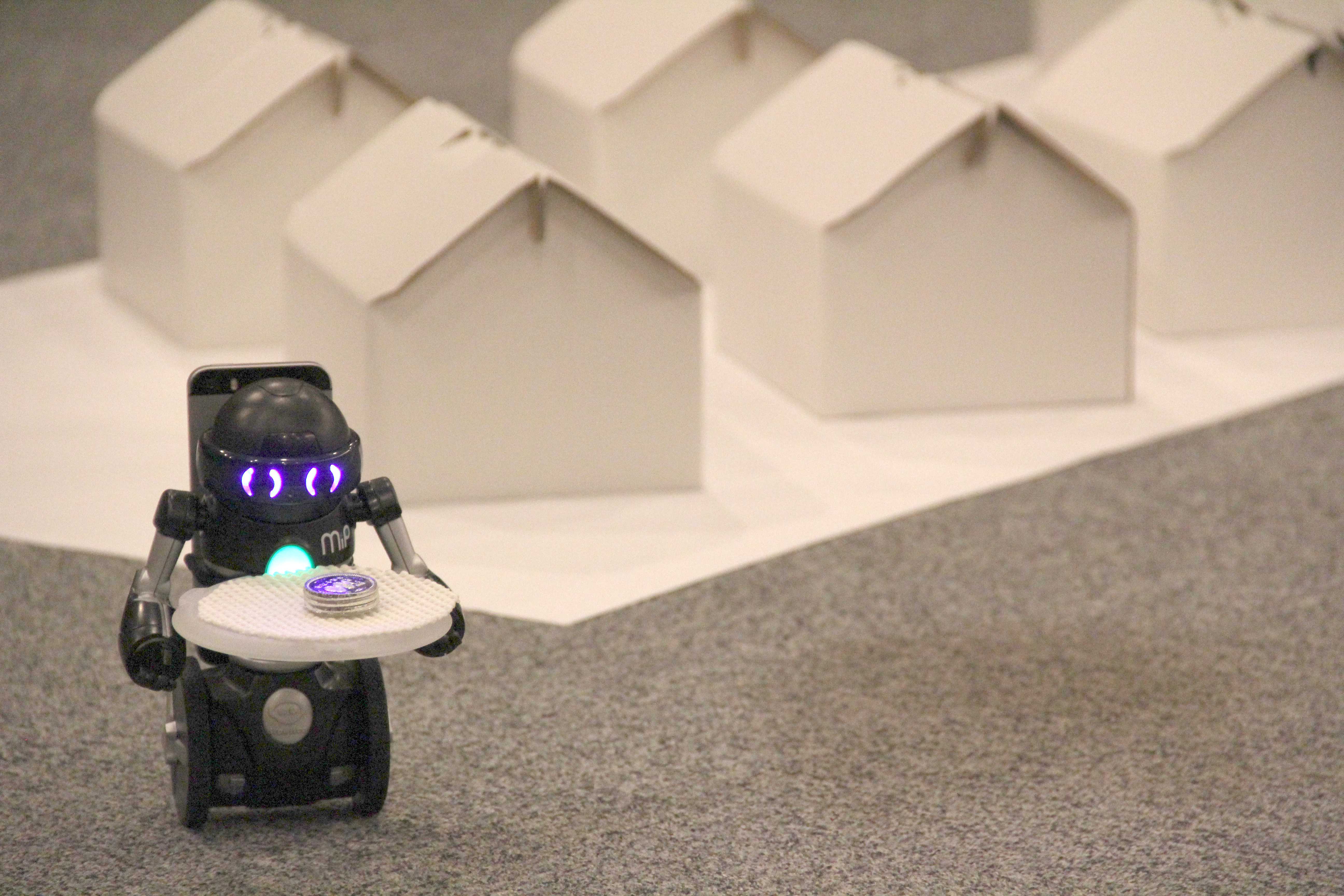Lifestyle authentication gains momentum Robots help researcher Rie Yamaguchi demonstrate her novel lifestyle authentication system

The Center for Social ICT Research at the University of Tokyo, with partners Mitsubishi UFJ NICOS, Toppan Printing, Mitsubishi Electric Information Systems and Hitachi, announced plans to develop lifestyle authentication – an innovative system to simplify and secure life in the digital age – with a robotic demonstration to illustrate key ideas.
 As two tiny robots trundle round a miniature mock-up of a town, one turns a corner and parks itself in a “coffee shop,” which promptly glows green. There a barista (played by a human) instantly places a small white paper cup on the robot’s outstretched hands and the robot rolls away without hesitation. The second robot then pays a visit to the coffee shop, which now glows red. This time the barista takes the robot’s order, and cash, gives her customer a brown paper cup and the robot saunters off to join its partner.
As two tiny robots trundle round a miniature mock-up of a town, one turns a corner and parks itself in a “coffee shop,” which promptly glows green. There a barista (played by a human) instantly places a small white paper cup on the robot’s outstretched hands and the robot rolls away without hesitation. The second robot then pays a visit to the coffee shop, which now glows red. This time the barista takes the robot’s order, and cash, gives her customer a brown paper cup and the robot saunters off to join its partner.
This display took place in Koshiba Hall at the University of Tokyo on October 10, 2018. It demonstrates one of the benefits of lifestyle authentication, personalized user experience across a range of services. The main purpose of the system, however, is to change the way security works in the digital domain.
Members of the press watched with glee as the robots repeated variations of this performance while the partner representatives congratulated Rie Yamaguchi, project associate professor at the Graduate School of Information Science and Technology, the brain behind the system. With the backing of established finance and technology firms such as Mitsubishi UFJ NICOS, Toppan Printing, Mitsubishi Electric Information Systems and Hitachi, you can expect to see lifestyle authentication in the palm of your hands before long.
 We’ve all used passwords, ID cards and fingerprints, but lifestyle authentication is a more nuanced way to log into apps and devices, pay for things or identify yourself to third parties such as retailers. The system allows a sophisticated record on your smartphone to serve as your identity, and should your phone be lost, damaged or stolen, the system is robust enough to detect something is amiss.
We’ve all used passwords, ID cards and fingerprints, but lifestyle authentication is a more nuanced way to log into apps and devices, pay for things or identify yourself to third parties such as retailers. The system allows a sophisticated record on your smartphone to serve as your identity, and should your phone be lost, damaged or stolen, the system is robust enough to detect something is amiss.
The record in question is a snapshot of data that is unique to you: things like journeys, purchase history or biometric data. This record is continually fed into a secure and centralized repository against which the record is compared each time you authenticate. If there is a significant mismatch, the system will fall back to currently established methods of authentication such as PINs and passwords. All this means it’ll become increasingly difficult to commit identity fraud while maintaining a stress-free experience for users.
You can find out more about lifestyle authentication at the Center for Social ICT Research.

The barista knew the first robot was coming and had its favorite beverage ready for it. Image ©2018 Rohan Mehra - The University of Tokyo, Division for Strategic Public Relations.
This display took place in Koshiba Hall at the University of Tokyo on October 10, 2018. It demonstrates one of the benefits of lifestyle authentication, personalized user experience across a range of services. The main purpose of the system, however, is to change the way security works in the digital domain.
Members of the press watched with glee as the robots repeated variations of this performance while the partner representatives congratulated Rie Yamaguchi, project associate professor at the Graduate School of Information Science and Technology, the brain behind the system. With the backing of established finance and technology firms such as Mitsubishi UFJ NICOS, Toppan Printing, Mitsubishi Electric Information Systems and Hitachi, you can expect to see lifestyle authentication in the palm of your hands before long.

Lifestyle authentication could become a common way to pay for things in daily life. Image ©2018 Rohan Mehra - The University of Tokyo, Division for Strategic Public Relations.
The record in question is a snapshot of data that is unique to you: things like journeys, purchase history or biometric data. This record is continually fed into a secure and centralized repository against which the record is compared each time you authenticate. If there is a significant mismatch, the system will fall back to currently established methods of authentication such as PINs and passwords. All this means it’ll become increasingly difficult to commit identity fraud while maintaining a stress-free experience for users.
You can find out more about lifestyle authentication at the Center for Social ICT Research.






